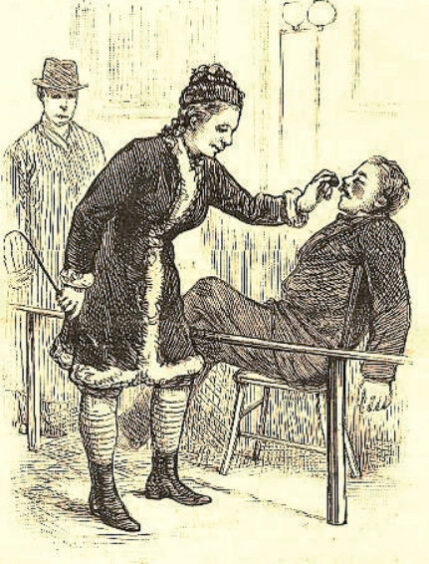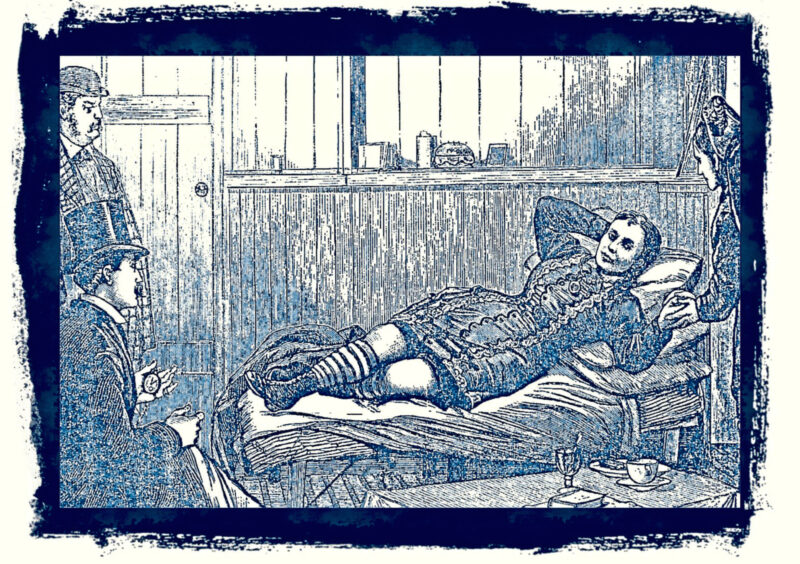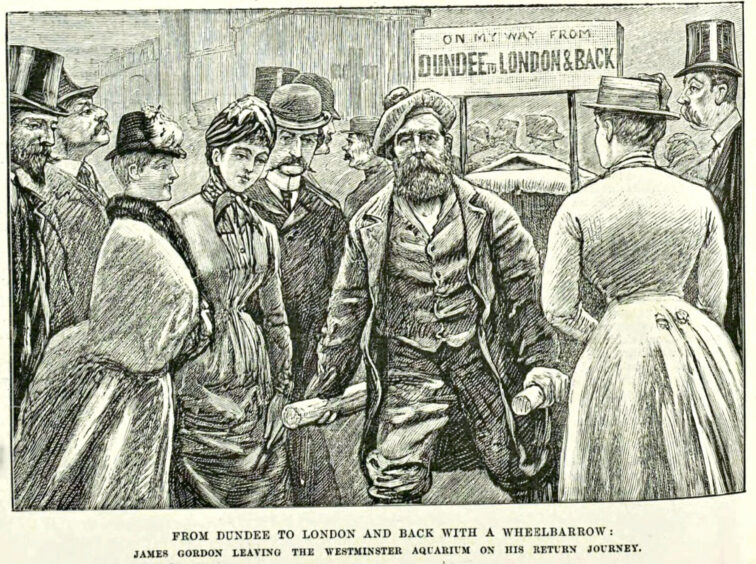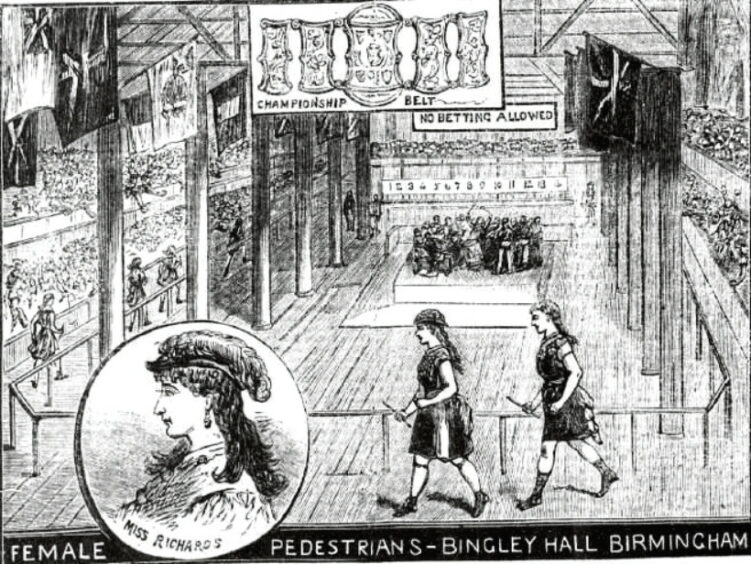The Scottish women walkers who became sporting celebrities
A new book shines a spotlight on “walkers” — competitive hikers who were often taunted and attacked for participating in late 19th-century sports.
They walked mile after mile, day after day – often all alone and frequently dressed in bloomers – to entertain the public and earn money to support their families.
The working-class women who participated in professional “pedestrianism” were often ridiculed, denounced, and even attacked.
But some stuck with it and emerged as strong, brave, and talented characters.
Inspired by her bravery, author Rob Hadgraft delved deep into the forgotten world of professional female pedestrianism, an occupation largely confined to the second half of the 19th century.
Ultimately, he concludes that these pioneering Victorian-era ladies laid the foundation for modern women to be able to participate in competitive sports.
Pioneers in Bloomers
Rob’s book Pioneers in Bloomers: The True Story of the Pedestrians – British Sport’s First Female Celebrities tells the stories of women who rose to prominence despite obstacles and prejudice and became the largely unsung pioneers of women’s sport.
He explores the lives and “remarkable adventures” of 21 women, including several from Dundee, Perth, Crieff and Aberdeen.
“Dozens of these working-class women gave up their monotonous lives to become the first professional athletes in history,” recalls Rob, from North Essex.
“They boldly put aside personal safety and decency to complete amazing walking competitions of 1,000 miles or more, compete against each other or against the clock, and chase cash prizes to feed and clothe their families.”
Shocked by her boldness
Victorian society was shocked by her boldness. A handful became rich and famous, but many had a torrid time.
Huge crowds came to watch them wander endlessly, often into the early hours of the morning. While the public loved them, authorities wanted them banned.
“The walks were often riotous affairs that attracted gamblers, drinkers and rowdy behavior, but it was the women themselves who were reviled in the press and condemned as immoral and despicable,” says Rob.
“The controversy only escalated when they adopted the daring new ‘Bloomers’ costume from America.
“This proved far more practical when walking, running, or cycling than the billowing skirts that women of the time were supposed to wear.
“They had to defy critics who believed women in bloomers were consciously trying to reduce social differences by donning these pants-like garments.”
Discouraged
It needs to be discouraged, exclaimed The Dundee Courier of the Day, which declared: “Why would ladies fight with their petticoats?”
The paper hinted that a cunning scheme was afoot to enforce women’s rights by allowing them to “wear jodhpurs” in relationships and in society.
While the public loved them, the authorities wanted them banned.”
Research
Rob, who spent 26 years as a journalist for local newspapers before turning to freelance research and writing on sports history, was inspired to write his new book after a “well-known historian” suggested he study the life of “Madame Angelo” – a woman who achieved great success on the pedestrian street in Victorian times, overcoming barriers including the fact that she was female and multiracial.
“After delving back into this fascinating and forgotten world, I decided to write a book about 21 or so British women who, like Madame Angelo, became known as ‘the Pedestrians’ and had some remarkable adventures,” he says.
“In 2023, with professional women’s sport thriving in the UK, it seemed time to celebrate 150 years ago those brave pioneers who paved the way and laid the foundation for modern women to play sport for a living. “
dying sport
Towards the end of the 19th century, pedestrianism in Britain was dying, says Rob, and was being overtaken by properly regulated activities like football and amateur athletics.
In 1886, however, there was a sudden and unexpected renaissance in Scotland in the form of the women’s six-day race.
“Meanwhile, men had largely abandoned multi-day running events, and the notable resurgence north of the border has been driven almost entirely by women.
“There would be seven women-only Walk tournaments in Britain this year – four in Aberdeen, two in Dundee and one in Glasgow.
“They drew huge crowds and six leading professionals who had run out of opportunities in the South came from England to join the action.”
walking competitions
In February 1886, John Gibb, proprietor of the Bon Accord Recreation Hall on Market Street, Aberdeen, offered a prize of £60 (equivalent to around £10,000 today) of three hours of action a night.
He recruited a handful of “London ladies” – well-known names in the sport – who arrived after the 36-hour boat trip, having suffered from seasickness.
Around 5,000 people crowded around the hall’s wooden indoor running track, defying previous claims in the press that such a spectacle would ‘shock the decency of an Aberdeen audience’.
Rob says, “The partisan crowd enjoyed the sight of local women Lizzie Reith and ‘Miss Lorimer’ beating four veteran Southerners in the week-long competition.
“Reith passed Lorimer by inches in a stunning finish that wowed the raucous crowd.”
Dundee is in on the action
Three weeks later, Dundee got some of the action. The city held an event of a similar nature, utilizing the tiny 42 yards per lap Newsome’s Circus track, which at the time was in the Craig Pier area of Dundee.
“Admission was a shilling for a reserved seat, or sixpence in the evening,” says Rob.
“Dundonians have licked it and turned up by the thousands. With a live orchestra providing the soundtrack, the crowds enthusiastically roared Miss Lorimer to victory. She took first prize of £20 (£3,300 in today’s price) ahead of Londoner ‘Madame Lucelle’.”
Aberdeen antics
When the Southerners returned to Aberdeen in May for a 14-hour event, they once again faced off against locals Miss Lorimer and Miss Reith.
Accomplished English walkers Kate Brown and Madame Englo also took part, but it was the Aberdeen girls who celebrated an extraordinary triumph, collectively taking home the £60 prize, led by Miss Jeffrey, who covered 83 miles in 16 hours.
Claustrophobic
Rob says the indoor events are “not for the faint hearted”.
“They didn’t take place in the large assembly halls or gymnasiums that some of the participants were used to, but on narrow and claustrophobic temporary wooden tracks. That meant walking in multiple laps made the task both mentally and physically more difficult.
“A previous event at Perth’s Drill Hall involved a track as small as 40 yards in circumference, which resulted in heated tempers and brawls and disqualification for at least three performers.”
The fact that the women had made money simply by walking long distances inevitably drew the attention of non-athletes desperate for money to survive.
wheelbarrow pusher
Two Dundee men, James Gordon and John Cochrane, were examples of a string of destitute Scots who set out for London in wheelbarrows, earning sympathy and donations along the way.
A Mrs. Adams attempted the same, also bound for the English capital, 450 miles from her home in Crieff.
She was soon followed by a mother of four, Mrs McGowan from Perth, whose husband was unemployed. She decided to push a stroller to London with her eight-month-old baby.
Unsympathetic
The press of the time was largely unsympathetic: “It’s high time this kind of nonsense ended,” declared The Courier.
One of the “top” performers was Aberdonian Margaret McPhee, under the stage name “Miss Lorimer,” says Rob.
Married with young children, Margaret’s participation in sports caused arguments at home.
attack
“In early 1886, her husband was arrested for allegedly assaulting her after they argued that walking should take precedence over their domestic duties,” says Rob.
“The Aberdeen Weekly Journal said this episode should be a warning to all women thinking of becoming pedestrians.
“When the McPhees appeared in court in Aberdeen, the judges heard that husband William was a scavenger (street cleaner) who had attacked his wife at their home on Seamount Place. She was described as a former fishwife who had found fame as a pedestrian.
“The day after her victory in the 16 Hour Walking Tournament in Dundee, Margaret was exhausted and rested in bed.
“William knelt on her chest and grabbed her by the throat and said he would make sure she never tired again by killing her.
“The children started screaming and the police were called and took him away. He was found guilty of assault and fined 10s 6d with the alternative of five days in prison.”
popularity waned
With the advent of Victorian six-day endurance sports such as swimming and cycle racing towards the end of the 19th century, the pedestrian zone’s popularity began to wane.
“However, the series of women’s races in Aberdeen and Dundee in 1886 kept the flame burning a little longer and provided unforgettable entertainment for thousands,” says Rob.
“The brave pioneers like Miss Jeffrey and Miss Lorimer would in time prove to be the seminal Victorian predecessors of the region’s female sports superstars – like Liz and Eilish McColgan, Kirsty Muir and Sinead Kerr, to name just three.”
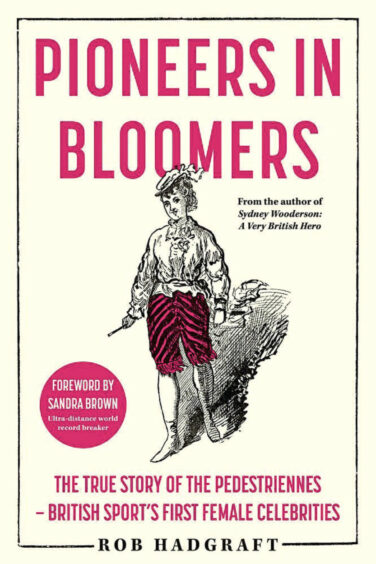
Already a subscriber? register
[The Scottish women walkers who became sporting celebrities]
[[text]]

